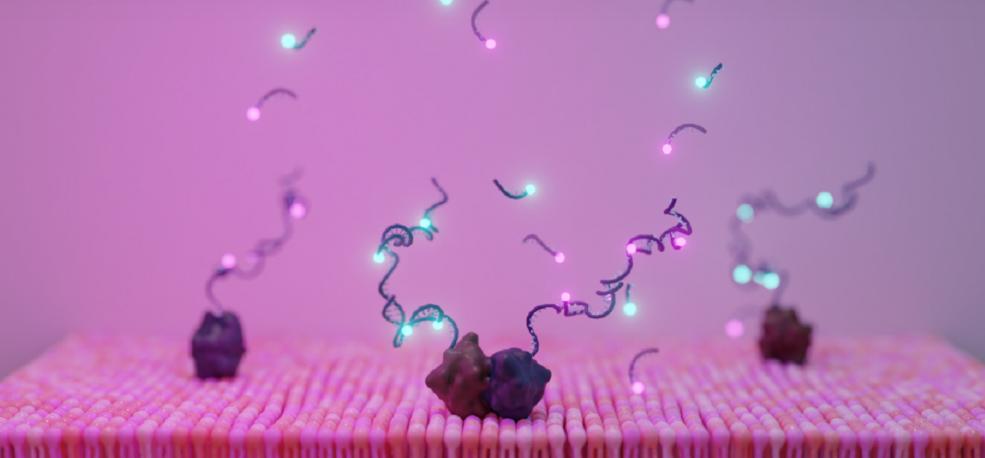博文
研究细胞间相互作用的新技术
||
研究细胞间相互作用的新技术
诸平
据荷兰阿姆斯特丹自由大学(VU University Amsterdam)2023年10月6日提供的消息,荷兰和德国的科学家合作,开发出研究细胞间相互作用的新技术(New technique to study the interaction between cells)。
细胞是生命的基础。为了更好地理解基本的生命过程,我们需要理解用于相互交互的语言细胞(language cells)。阿姆斯特丹自由大学(Vrije Universiteit Amsterdam)的生物物理学家克里斯蒂安·尼德奥尔(Christian Niederauer)开发了一种新方法来研究这种相互作用。
通过使用DNA作为可编程构建模块,克里斯蒂安·尼德奥尔创建了能够不断自我更新并且不会像普通荧光标签(fluorescent labels)那样褪色的荧光标签。这使得研究人员能够研究生物分子如何长时间协作。
这一发现对于研究基本细胞过程的科学家和旨在开发靶向疗法的医学研究人员来说,在各个领域都具有重大的实际意义。通过揭示分子在生物体中如何相互作用,我们可以深入了解疾病并开发更有效的治疗方法。克里斯蒂安·尼德奥尔解释说:“例如,如果我们了解蛋白质在癌细胞中如何相互作用,我们就可以开发出新的治疗方法来破坏这些相互作用并阻止肿瘤生长。”
基于DNA的自我更新荧光标记(Self-renewing fluorescent labels based on DNA)
这项研究结合了生化实验室工作、先进的单分子荧光显微镜(single-molecule fluorescence microscopy)和复杂的数据分析。克里斯蒂安·尼德奥尔开发的自我更新荧光标签被应用于活细胞和人工系统上有趣的分子。通过在专门的显微镜下观察这些标签分子,可以以20~30 nm的精度追踪几分钟的相互作用。
尽管克里斯蒂安·尼德奥尔将于10月19日就这一新进展进行论文答辩,但该研究的相关论文于2023年7月19日已经在《自然通讯》(Nature Communications)杂志网站发表——Christian Niederauer, Chikim Nguyen, Miles Wang-Henderson, Johannes Stein, Sebastian Strauss, Alexander Cumberworth, Florian Stehr, Ralf Jungmann, Petra Schwille, Kristina A. Ganzinger. Dual-color DNA-PAINT single-particle tracking enables extended studies of membrane protein interactions. Nature Communications, 2023, 14, Article number: 4345. DOI: 10.1038/s41467-023-40065-8. Published: 19 July 2023. https://www.nature.com/articles/s41467-023-40065-8
参与此项研究的除了来自荷兰阿姆斯特丹AMOLF(AMOLF, Amsterdam, The Netherlands)的研究人员之外,还有来自德国马克斯·普朗克生物化学研究所(Max Planck Institute of Biochemistry, Martinsried, Germany)和德国路德维希·马克西米利安大学(Ludwig Maximilian University, Munich, Germany)的研究人员。
本研究得到了荷兰研究理事会NOW(Dutch Research Council NWO)资助的人才计划项目(Talent Programme,the project number VI.Vidi.203.037)的支持,也得到了荷兰科学研究组织(Nederlandse Organisatie voor Wetenschappelijk Onderzoek简称NWO)WISE项目(WISE program of NWO)的支持。
上述介绍,仅供参考。欲了解更多信息,敬请注意浏览原文或者相关报道。
DNA-PAINT based single-particle tracking (DNA-PAINT-SPT) has recently significantly enhanced observation times in in vitro SPT experiments by overcoming the constraints of fluorophore photobleaching. However, with the reported implementation, only a single target can be imaged and the technique cannot be applied straight to live cell imaging. Here we report on leveraging this technique from a proof-of-principle implementation to a useful tool for the SPT community by introducing simultaneous live cell dual-color DNA-PAINT-SPT for quantifying protein dimerization and tracking proteins in living cell membranes, demonstrating its improved performance over single-dye SPT.
https://blog.sciencenet.cn/blog-212210-1405165.html
上一篇:2D材料已成为研究人员的宝库
下一篇:研究人员用超快“电子相机”捕捉质子解离过程
